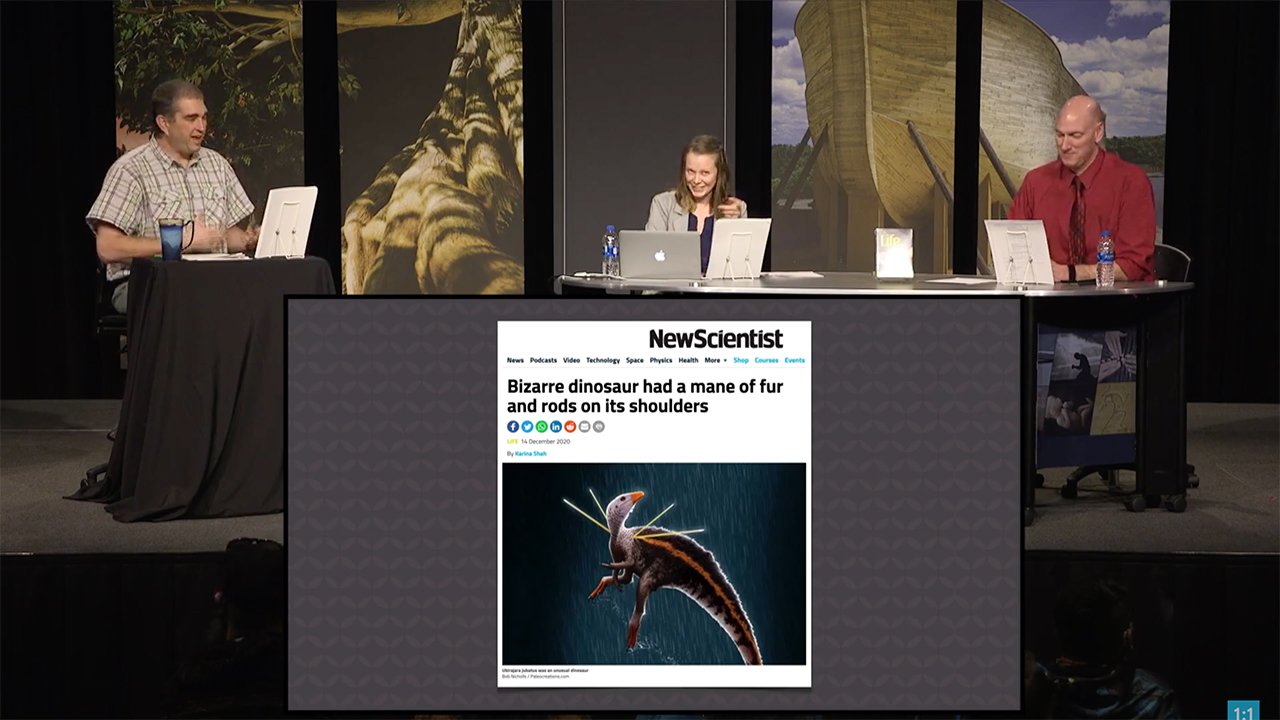
Dinosaur with Mane of Fur and Shoulder Rods?
To say a new “dinosaur” being described by news media as “unusual” would be an understatement! This new “dinosaur,” Ubirajara jubatus, is described as having “a long mane of fur [really, structures that might have been feathers] down its back and stiff [nearly 6-inch] rod-like structures projecting from its shoulders.” It’s “totally weird,” one researcher says. So what is it really?
Well, our paleontologist Dr. Gabriela Haynes read the original scientific paper, and here’s what she had to say about this crazy-sounding creature:
It is important to understand the way that evolutionist researchers name and group animals today.A lot has been said about dinosaurs, birds, and feathered dinosaurs, but there are a lot of assumptions and interpretations involved in all of that. It is important to understand the way that evolutionist researchers name and group animals today. Two of the assumptions involved in that process are that all the organisms are connected somehow and that they have also evolved.
There are five points I would like to bring up:
- For this particular fossil, not a lot of the fossil material was found. This can make the identification and classification a challenge. When we are studying vertebrates, the chance of finding the whole animal, complete and articulated, is not very high (it is possible, but it is not the case for this fossil).
- Birds and dinosaurs are placed together in the same group because of evolutionary assumptions. That is why many times when they find a bird, they call it a dinosaur. Definitions have been changing, not because of evidence but because of arbitrary choices based on the evolutionary worldview. Since they believe all the organisms have shared ancestry, in this case, they believe that a group of dinosaurs (theropods) and birds share a close relationship.
- Most of the reconstruction (based on interpretation and assumptions) shows a dinosaur, but only a small part of the material was found—the rest is just interpretation.
- There is a bird that displays a similar structure; there is no known dinosaur with something like it. As the scientific paper states, “Such elaborate integumentary structures are hitherto unknown in any other dinosaur, although superficially similar elongate display feathers emerge from the carpal region of the male standardwing bird-of-paradise (Semioptera wallacii).” Keep in mind, we don’t even know for sure if these are indeed feathers.
- Most, if not all, of the genera cited in the scientific article have not been proven to have had feathers. Some of those genera are misclassified or the structures preserved are misunderstood. There are also questions about their identification and classification, whether they are a bird or a dinosaur.
All that is confusing and difficult to explain in the evolutionary perspective, but in the creation worldview it is much easier—and it’s reasonable to see the differences between those two different created kinds.
So, to summarize, the fossil remains are really too limited to make a determination about whether this is a dinosaur or a bird—and even if the “mane” is even feathers! But because of evolutionary assumptions, researchers are interpreting this as a feathered dinosaur with some very bizarre features.
For all of these soft tissues to be preserved requires rapid burial—just the kind of burial we’d expect from the global flood of Noah’s day.
Interestingly, the researchers note “the fossil shows amazing preservation of structures other than the skeleton, including decayed remains of the guts and body organs, as well as the feathers [but, as Dr. Haynes said above, we don’t even know if they are feathers] and long rod-like structures.” For all of these soft tissues to be preserved requires rapid burial—just the kind of burial we’d expect from the global flood of Noah’s day.
This creature, like all others, displays the glory of God. And it didn’t live 110 million years ago—it lived just a few thousand years ago and was drowned and rapidly buried during the cataclysmic flood of Noah’s day.
Get More Answers on Answers News
This item was discussed yesterday on Answers News with cohosts Roger Patterson, Tim Chaffey, and Avery Foley. Answers News is our twice-weekly news program filmed live before a studio audience here at the Creation Museum and broadcast on my Facebook page and the Answers in Genesis Facebook page. We also covered the following topics:
- Should we call women “birthing people”? (Harvard thinks so!)
- New video game features an unborn baby . . . and you have to shoot him or her!
- Where are new species most likely to evolve?
- And more!
Be sure to join us each Monday and Wednesday at 2 p.m. (ET) on my Facebook page or the Answers in Genesis Facebook page for Answers News. You won’t want to miss this unique news program that gives science and culture news from a distinctly biblical and Christian perspective.
Thanks for stopping by and thanks for praying,
Ken
This item was written with the assistance of AiG’s research team.
Most Recent News
-
April 25, 2024 from Ken Ham Blog
A recent article made the bold claim that feathers are one of evolution’s greatest inventions. But what proof did they offer?
-
April 22, 2024 from Ken Ham Blog
Colorado law is all too happy to let medical staff prescribe the “abortion pill” (RU-486) to their patients, but it’s not so willing to allow for reversal.
Recommended Resources

Answers in Genesis is an apologetics ministry, dedicated to helping Christians defend their faith and proclaim the good news of Jesus Christ.
- Customer Service 800.778.3390
- © 2024 Answers in Genesis






